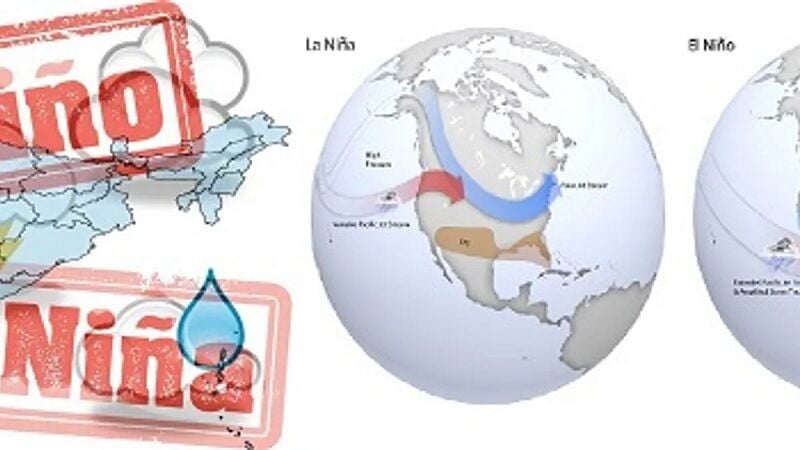The effects of El Nino and La Nina

As one ventures into the complex realm of climate phenomena, it becomes evident that the significant influence of El Niño and La Niña on global weather patterns cannot be understated. Originating from the Pacific Ocean, these climatic events have extensive implications that affect regions worldwide, Comprehending their impact is essential for forecasting weather alterations and preparing for resultant outcomes.
El Niño and La Niña, integral components of the El Niño Southern Oscillation (ENSO) cycle, are instrumental in modifying global weather conditions. El Niño leads to an increase in Pacific water temperatures, resulting in drier, warmer conditions in certain areas, whereas La Niña reduces these temperatures, often causing wetter, cooler climates elsewhere. The consequences of these events transcend mere temperature fluctuations; they influence precipitation distribution, storm occurrences, and even the likelihood of droughts and floods.
Understanding the intricacies of these phenomena is not merely academic—it is vital for strategic planning and resilience building. Whether it involves agricultural scheduling or municipal preparations for extreme weather incidents, acknowledging the effects of El Niño and La Niña is profoundly relevant. A deeper exploration of their impacts will provide insights into how these formidable natural forces shape our climate.
Understanding El Niño and La Niña

At their essence, El Niño and La Niña represent significant elements within the climate system that fundamentally alter weather patterns globally. These phenomena serve as oceanic manifestations within the ENSO cycle by inducing temperature variances in Pacific Ocean waters. Specifically, El Nino elevates water temperatures, disrupting typical meteorological patterns, which can lead to increased precipitation in some regions while instigating droughts elsewhere. In contrast, La Nina lowers Pacific temperatures, producing effects somewhat antithetical to those observed during El Nino years, such as drier conditions in typically moist regions during El Nino periods and heightened rainfall elsewhere.
Formation mechanisms
The genesis of both El Nino and La Nina revolves around interactions between oceanic waters and atmospheric conditions across tropical sections of Pacific realms where shifts commence with variations among trade winds traditionally propelling warm surface waters westward towards Asia. For instance, when such trade winds weaken warmer waters tend to flow eastwards towards South America incrementing sea-surface temperatures along Eastern Pacific territories conversely strengthening normal trade wind velocities and accentuating westward warm water movement culminating into cooler Eastern Pacific zones through upwelling cold deep-water currents hence initiating la ninas episodes
These occurrences exert wide-reaching effects propagating beyond their origin point, influencing global weather paradigms exampled by adjustments against Thailand’s monsoon, potentially impacting national agriculture alongside regional hydrological resources highlighting the necessity of monitoring ENSO phases foreseeing potential world meteorological developments thereby preparing respective countermeasures.
Worldwide climatic impacts
El Nino notably bears a critical role in altering universal atmospheric setups through warming Eastern Pacific aquatic surfaces unsettling foundational air circulation models and triggering diverse planetary climate repercussions Regions frequently encounter diminished precipitations escalating drought probabilities inversely portions within South America specifically coastal locales witness augmented rainfalls potentially inciting floods landslides incidences.
EL nino persuasion extends towards gentler winters furthermore propagating its effects unto distant Earth corners effectuating monsoon systems exemplified through Thai scenarios wherein EL nino might suppress monsoonal activities adversely influencing local agrarian sectors plus aquatic reserves Such disruptions underscore El Nino’s expansive reach delineating its capability perturbing international meteorological patterns well beyond originating pacific confines.
Economic ecological repercussions
Beyond mere atmospheric alterations, their ramifications significantly impinge on economies and ecosystems Economically and agriculturally fishery-dependent nations are particularly susceptible to instances wherein reduced rainfalls provoke crop failures diminishing food productions escalating prices, securing sustenance Countries reliant on hydroelectric power witness production declines impacting industrial populace segments similarly.
Ecologically, El ninos thermal enhancement upon oceanic bodies leads to coral bleaching jeopardising coral reef habitats and marine biodiversity Fisheries endure altered aquatic temperature ranges disturbing numerous fish species’ habitats and resulting in stock diminishments Additionally prevalent weather pattern transitions exacerbate forest fires, especially in drought-afflicted areas further deteriorating air quality biomes.
Broadly speaking el ninos sphere influences vast intertwining environmental climatic dimensions touching upon economies and communities comprehensively Grasping its impacts fosters enhanced preparation mitigation strategies emphasising international collaborative efforts addressing challenges posed by this potent climactic entity.
Worldwide weather patterns effect
Regarded often as El ninos counterpart La Nina introduces distinctive global meteorologic anomalies Following the onset equatorial Pacific waters experience cooling dramatically shifting atmospheric circulations contrary to El Nino bolstering trade winds and fostering colder wetter circumstances locations typically arid throughout El Nino phases.
The Southern United States may confront warmer, drier climates, starkly contrasting cool, rainy weathers ushered via EL Ninho Conversely, the Pacific Northwest habitually greets colder, moisture-laden climates, affecting everything ranging agriculture daily existences Across Atlantic Europe could brace colder winters albeit connections aren’t direct compared closer proximate pacific locales.
Asia Australia is particularly sensitive, la minhas affections countries like Thailand la nina could augment monsoonal seasons heightening flooding risks and threatening water management agricultural sectors Australia prone draught during EL Ninho intervals might welcome much-needed precipitations alleviating dry spells.
Societal environmental influence dimensions

La Nina sway transcends simple temperature and precipitation modifications, deeply influencing societal environmental fabrics Economies agriculture-centric might discover relief strains under LA Ninas dominion Ample rains enhance crops excessively however induce damaging floods Thailand possesses considerable agrarian segment faces a dual-faceted sword in nearly every La Nina occurrence.
Environmentally, La Ninas cooler seas offer solace to coral reefs previously stressed via EL Nino warmth reducing widespread bleaching event probabilities Nonetheless, surged rainfalls foster erosion runoff, potentially harming marine ecosystems near coastlines Understanding las distinct differences from her counterpart underscores the complexity of inherent global atmospheric paradigms Recognising impacts enables superior anticipation response challenges introduced via these natural climatologic phenomena.
El Niño and La Niña are the real MVPs of our wealth, They’re like the puppeteers of the atmosphere, pulling strings left and right. With climate change potentially cranking its impact up to eleven, we must keep our eyes peeled on their every move. Diving deep into the ins and outs of El Niño and La Niña gives us a golden ticket to be ahead of the game, ready for whatever weather wizardry comes our way. It’s all about arming ourselves with knowledge.
Considering the above shared you can also check out, What to Do in Bangkok this weekend, This weekend in Bangkok is full of zest and jazz, literally. From dinners by the Chao Phraya River to Earth Day celebrations to live jazz music, there are a lot of things to do to keep you cool and entertained this weekend.
Latest Thailand News
Follow The Thaiger on Google News:


























